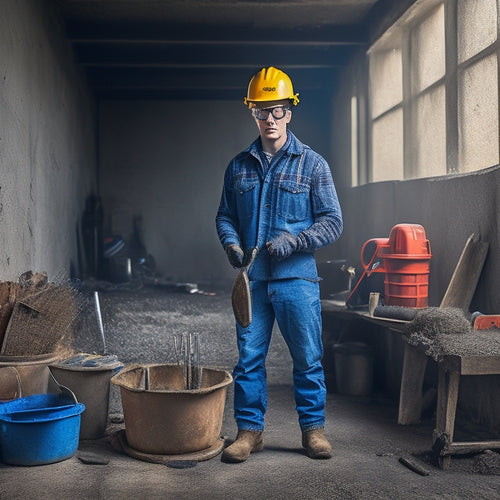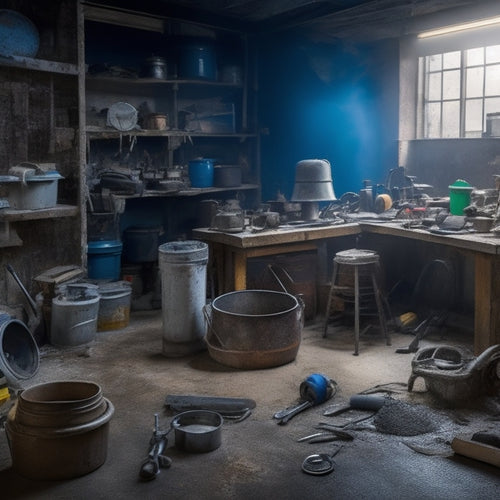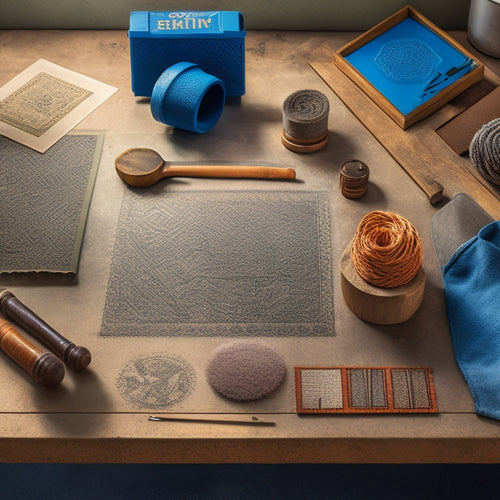
3 Best Concrete Polishing Tools for Beginners
Share
As a beginner, you'll want to focus on investing in a reliable concrete grinder, a high-quality polisher, and a set of diamond abrasives. For grinders, consider brands like Makita, Bosch, or DeWalt, while polishers from Metabo, Hitachi, or Festool with variable speed are ideal. 3M, Saint-Gobain, or Tyrolit offer excellent diamond abrasives. Remember, quality and safety should be top priorities when selecting tools. You'll also need essential accessories like a dust collector, water tank, and polishing pad cleaner. By choosing the right tools, you'll be well on your way to achieving a high-shine finish; now, it's time to take the next step and discover the specific tools you'll need to succeed.
Key Takeaways
• Invest in a reliable grinder from brands like Makita, Bosch, or DeWalt with adjustable speed settings for efficient concrete preparation.
• Choose a polisher with variable speed from Metabo, Hitachi, or Festool for a high-shine finish and versatility.
• Select high-quality diamond abrasives from 3M, Saint-Gobain, or Tyrolit for effective concrete polishing and longevity.
• Don't forget essential accessories like a dust collector, water tank, and polishing pad cleaner for a safe and efficient polishing process.
• Start with a basic kit including a concrete grinder, metal-bonded diamond discs, and concrete-specific polishing pads for a high-shine finish.
Top Picks for Beginners
You'll want to start with the essentials, and we recommend investing in three must-have concrete polishing tools: a grinder, a polisher, and a set of diamond abrasives.
When it comes to choosing the right tools, it's vital to opt for top brands that prioritize safety and quality. Look for brands that have received excellent user reviews and adhere to industry standards.
For grinders, consider top brands like Makita, Bosch, or DeWalt, which offer high-torque motors and durable construction.
For polishers, Metabo, Hitachi, or Festool are excellent choices, providing variable speed control and ergonomic design.
When it comes to diamond abrasives, opt for reputable brands like 3M, Saint-Gobain, or Tyrolit, which offer a range of grits and bonding systems.
Must-Have Polishing Essentials
Three core components form the foundation of your concrete polishing arsenal: a dust collector, a water tank, and a polishing pad cleaner. These essentials guarantee a safe and efficient polishing process.
You'll need a dust collector to contain the dust generated during surface preparation, preventing it from spreading and posing a health risk. A water tank is vital for maintaining the right amount of water for your polishing techniques, as excess water can lead to uneven finishes. A polishing pad cleaner helps extend the life of your pads, keeping them free from debris and residue that can affect their performance.
When it comes to surface preparation, you'll want to verify your concrete is properly cleaned and prepared for polishing. This involves removing dirt, oil, and other substances that can interfere with the polishing process.
Start-Up Tool Kit Essentials
Your start-up tool kit should include a concrete grinder, a set of metal-bonded diamond discs, and a few polishing pads, which form the backbone of your concrete polishing operation. These essentials will help you achieve a high-gloss finish and lay the foundation for more advanced polishing techniques.
When selecting your tools, consider your budget and prioritize quality over quantity. Invest in a reliable concrete grinder that can handle heavy loads and has adjustable speed settings.
For metal-bonded diamond discs, choose a set that includes various grit levels (16, 30, 60, and 120) to tackle different stages of polishing. Don't forget to include a few polishing pads in your kit, specifically designed for concrete, to achieve a high-shine finish.
Remember to always follow safety protocols when working with these tools, including wearing protective gear and ensuring proper ventilation. By following these tool selection tips and budget considerations, you'll be well on your way to creating stunning polished concrete floors.
Frequently Asked Questions
What Safety Gear Is Required for Concrete Polishing?
When you're concrete polishing, you're working with abrasive materials and powerful equipment, so it's vital you wear the right safety gear.
You'll need to invest in essential safety equipment, including a dust mask or respirator to protect yourself from silica dust and other airborne particles.
Don't forget protective clothing like gloves, safety glasses, and a long-sleeved shirt to prevent skin and eye damage.
Can I Polish Concrete Floors With a Low Ceiling?
When working with a low ceiling, you'll need to adapt your polishing techniques to maintain efficiency.
First, assess the space to determine the best equipment size and maneuverability. Consider using smaller, lighter machines that can easily navigate tight spaces.
Additionally, adjust your polishing pattern to minimize overhead movement, reducing the risk of accidents and improving overall polishing efficiency.
How Do I Handle Cracks and Joints During Polishing?
You're wise to prioritize crack repair and joint filling before polishing. Research suggests that ignoring these imperfections can lead to further damage and compromise the integrity of your floor.
To guarantee a smooth, safe process, fill joints with a concrete joint filler and repair cracks with a crack repair compound specifically designed for concrete.
This essential step will prevent further damage and guarantee a successful, high-gloss finish.
Can I Use a Polishing Tool on Epoxy or Polyurethane Coatings?
When considering epoxy polishing or polyurethane refinishing, you'll need to exercise caution.
These coatings can be delicate, and using the wrong polishing tool can damage the surface. You'll want to choose a tool specifically designed for epoxy or polyurethane, as they require gentle, controlled movements to avoid scratches or marks.
Always follow the manufacturer's guidelines and take necessary safety precautions to guarantee a successful and safe refinishing process.
How Often Should I Maintain My Concrete Polishing Tools?
You should establish a regular maintenance schedule to guarantee your concrete polishing tools stay in top condition.
Clean your tools thoroughly after each use, removing any residue and debris.
Perform weekly tool cleaning and inspection to prevent damage and wear.
Additionally, set aside time for more in-depth maintenance every 3-6 months, such as replacing worn parts and sharpening blades.
Conclusion
As you step into the world of concrete polishing, remember that the right tools are the keys to revealing a masterpiece.
With these top picks in your arsenal, you'll be well on your way to transforming dull, rough concrete into a stunning work of art.
Just as a painter needs the perfect brush, you need the perfect polishing tools to bring out the beauty hidden beneath the surface.
Related Posts
-

What Tools Do I Need for Concrete Wall Repair
As you prepare for a concrete wall repair job, you'll need a variety of tools to guarantee a successful outcome. Star...
-

7 Tools to Fix Damaged Concrete Floors
You're about to tackle that damaged concrete floor, and the right tools are essential for a successful repair. Start ...
-

5 Best Tools for Stamping Concrete Walls
When it comes to stamping concrete walls, you'll need a range of specialized tools to achieve the desired texture and...


